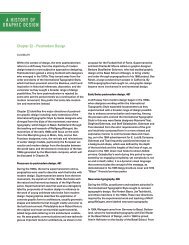Week 2 National Visions within a Global Dialogue - A History of ...
Week 2 National Visions within a Global Dialogue - A History of ...
Week 2 National Visions within a Global Dialogue - A History of ...
Create successful ePaper yourself
Turn your PDF publications into a flip-book with our unique Google optimized e-Paper software.
A HISTORY OFGRAPHIC DESIGNPaul (Pabrü) Brühwiler (b. 1939), page 506, began his graphic design studies in Luzern and in 1960 continued his educationin Paris. In 1963, he opened his own studio in Los Angeles where he collaborated periodically with Saul Pass.Brühwiler returned to Switzerland in 1973, working for clients such as the Swiss International Tourist Office, Swissair,Kunsthaus Museum, Museum Reitberg, and the Luzerner Theater (Figs. 23-75 and 23-76).Uwe Loesch (b. 1943), page 506, A native <strong>of</strong> Dresden, Germany, this designer provides the viewer with few clues to themeaning <strong>of</strong> his minimalist and arcane messages (Fig. 23-77).Holger Matthies (b. 1940), page 506, This graphic designer from Berlin and Hamburg delights in presenting ordinaryobjects and situations in unusual ways: tomatoes become sunglasses; a standing painted nude male advertises theexpertise <strong>of</strong> a printer; flaming matches become a man’s hair; and a circular saw blade is used as a palate (Fig. 23-78).Philippe Apeloig (1962), page 507, was educated at the École <strong>National</strong>e Supérieure des Arts Appliqués and the École<strong>National</strong>e Supérieure des Arts Décoratifs. He then worked as an intern for Total Design in Amsterdam. He began hisown studio and became the art director for Jardins des Modes, and then in 1997 he became a design consultant for theLouvre Museum, where he is currently the art director. His designs are dominated by an expressive and decisive use <strong>of</strong>typography that not only provides information but also functions as a visual pun (Fig. 23-79).Annette Lenz (b. 1964), page 507, after studying design in Munich, Lenz moved to Paris in 1990 where she worked atthe cultural-political design group Grapus. Having launched her own studio in 1993, she works mainly in the social andcultural sector designing elegant works for public spaces. (Fig. 23-80).Keith Godard (b. 1938), page 507, graduated from London College <strong>of</strong> Printing in 1962 and from the Yale University School<strong>of</strong> Art and Architecture MFA graphic design program in 1967. Since 1987 he has been the principal designer for Studio-Works and is involved with exhibition design, wayfinding, print design, public art, and information design. His recentwork could be described as “sculptural posters,” employing ambitious die cuts, stamping and folds which add a thirddimension to the traditionally two dimensional format (Figs. 23-81 and 23-82).Charles I. (Chip) Kidd (b. 1964), page 509, His designs for Alfred A. Knopf have helped to foment a revolution in bookjacket design. “By distancing the title from the image on the cover, [he] puts a very specific kind <strong>of</strong> pressure on readers:he asks them to bridge the gap between what they read and what they see” –Veronique Vienne in a monograph on hiswork. (Figs. 23-83 and 23-84).Katsumi Asaba (b. 1940), page 509, The founder <strong>of</strong> the Katsumi Asaba Design Office in 1975, one <strong>of</strong> his goals has been t<strong>of</strong>orge a connection between contemporary graphic design and ancient writing systems, as demonstrated by the jacketfor the book Spy Sorge. In the late 1980s he transformed a surviving pictographic script, Dongba (Tompa), used by theNaxi tribe in China, into a personal design language titled “Katsumi Asaba’s Tompa Character Exhibition: The Last LivingPictographic Script on Earth.” (Fig. 23-85).Emilio Gil (b. 1949), page 511, A former student <strong>of</strong> Milton Glaser and Ed Benguiat at the School <strong>of</strong> Visual Arts in NewYork, Gil has been creative director <strong>of</strong> Tau Design in Madrid since its founding in 1980. Tau Design is one <strong>of</strong> the pioneeringgraphic design studios in Spain, specializing in visual communication and corporate identity programs. Gil alsowrote and the book Pioneers <strong>of</strong> Spanish Graphic Design, the leading publication on this subject. His design reflects theaesthetic and direct manual involvement <strong>of</strong> designers working in post-war Spain; handwork is celebrated while juxtaposedwith modern typographic design (Figs. 23-87 and 23-88).Pablo Martín (b. 1964), page 511, Before establishing his own studio in 1990, Martín worked for Eskenazi & Associadosand Vignelli Associates. In 1995 he founded Grafica, working mainly in the areas <strong>of</strong> editorial design and corporateidentity. While his work is global in scope, it reflects the Spanish graphic heritage, bright with color, cheerful, and witty(Fig. 23-89).Manuel Estrada (b. 1953), page 511, strives for a balance between reflection, feeling, and intuition, he works initiallywith words and drawings, developing and refining ideas before taking them to the computer. Estrada is currently chair<strong>of</strong> the Madrid Designers’ Association, which manages the Central de Diseño de Matadero in Madrid. He is a member <strong>of</strong>the Higher Council <strong>of</strong> Artistic Teaching and is executive chairman <strong>of</strong> the Advisory Council <strong>of</strong> the Ibero American DesignBiennial (Figs. 23-90 through 23-97).
















